You are in: South America
Change location
You are here
Promote Your Journal
Social Media | Social Media Tips for Editors and Societies | Blogging | Press Releases | Journal Prizes
Increasingly, a variety of different online platforms are being used as places to discover, and engage with, research. Journal content is also no longer limited to just text; it now includes video, podcasts, images, datasets, photographs and maps. Multimedia content aids the discoverability and share-ability of content and allows users to engage with your publication. Sage Publishing is dedicated to supporting you to ensure that your journal is visible where the user starts their search. But where and how should you be sharing this content to engage and reach an audience beyond the core readership of your journal?
Below are some of the resources we think are key for promoting your journal, offering you a direct way to reach the widest and most appropriate audience.
Social Media
Twitter allows you to connect with your authors, as well as researchers and society partners within you field and beyond. You can share content from your publication as well as set up search terms to enable you to monitor what is being talked about in your areas of interest: you can then join in on conversations, and share relevant research from your journal. The more you engage, the more people will follow you to listen to your comments and recommendations, allowing you to position your journal as a leading source of information on specific topics and well as widen the reach and impact of your name.
Find out about Sage’s discipline specific channels.
Why not also create a Facebook page for your journal? Facebook lets users add ‘friends’ to build a network of researchers and organizations within a particular field. You can then share information and content from your journal. You can also join and create groups according to your journal’s interests or areas of expertise.
Enhance discoverability
Find out more about how to enhance discoverability using social media to help promote your article.

Social Media Tips for Editors and Societies
Social media is a powerful tool. Academics use social media to share research, build their digital presence, and connect with the scholarly community. Likewise, journal editors and societies can use social media to promote their publication and engage with a global audience.
This resource provides recommendations for social media for Sage journal editors and societies. It covers the following information:
- Social media best practices
- “What sort of content should I share on social media?”
- How to handle content sharing on controversial topics
- Using AI for social media content
- X/Twitter
- Meta (Facebook, Instagram, and Threads)
- TikTok
- Blogs and community websites
- Listservs
- YouTube
- Researcher profiles
Social media best practices
Below are some best practice recommendations across social media platforms.
- Be consistent across platforms. For instance, use the same high-quality profile picture on all your accounts.
- Use your real name (or the name you publish under).
- If you use your middle initial when you author papers, consider using it in your professional social media accounts as well.
- Incorporate your name into your handle.
- Include your affiliation(s) and field of study in your bio.

- If you create a separate account for your society or journal, keep track of your password.
- Note: Sage has no way to access accounts without login information.
- Use personal language.
- Social media posts should not be written in the style of a press release, marketing email, etc. Followers seek authenticity.
- Use inclusive language and add alt text or image descriptions for accessibility.
- Use CamelCase hashtags, which are easier to read and more accessible.
- E.g. #HigherEd, #WomenInAcademia, and #AdjunctLife rather than #highered, #womeninacademia, or #adjunctlife.
- Delete and report inappropriate or bullying comments.
- Do not engage with agitators.
- If you decide to delete a post, explain why. Your followers will understand that healthy discussion needs some moderation; provide a short list of reasons why comments may be deleted from the page. General language is fine, something like, “comments that are off-topic, offensive or inappropriate will be deleted.”
- Criticize ideas, not people.
- Do not send a direct message (DM) to someone you don’t know unless it is strictly professional.
- E.g., an introduction to a new connection on LinkedIn.
- Consider personal safety.
- Ask whether a stranger could learn the following from your online presence:
- Where you live.
- Where you are at a given time.
- Answers to common security questions such as your mother’s maiden name, the city in which you were born, or the name of your favorite pet.
- Remove home addresses from CVs and resumes, especially if these documents are attached to your LinkedIn profile, institutional bio, or other sites.
- Ask whether a stranger could learn the following from your online presence:
- Do not make a social media account with your institutional email address. If you change institutions, you might lose access to that email address and lock yourself out of your social media accounts.
- Remember to get permission when posting a picture of anyone or using any third-party materials.
If you are posting from a journal or society account, be sure to maintain a consistent tone of voice and be respectful of any journal or society policies. You are representing an organization, not just you as an individual.
“What sort of content should I share on social media?”
Consider sharing the following content across your social media platforms:
- Share and promote recent articles and issues.
- Highlight real-world impact. Celebrate your successes.
- Consider sharing topics that are considered “hot” in your discipline or field.
- Focus on articles published in the previous 2-3 years to ensure research is relevant and timely.
- Promote the latest journal issue and/or OnlineFirst articles.
- Announce publications, special collections, calls for papers, book launches, etc.
- Publicize speaking engagements or conferences.
- If possible “tag” or “mention” the event host or use an established hashtag.
- Remember to share your handles with your Sage publishing editor in order to be tagged or mentioned by us as well.
- Following the conference hashtag on social media is also a good way to find and engage with new content or share your perspective on current debates within the field that might tie into your journal or society.
- If possible “tag” or “mention” the event host or use an established hashtag.
- Conduct and feature interviews with authors, editors and/or society members.
- Share research in your field.
- Tip: Sign up for Sage Alerts to stay up to date on current research.
- Contribute brief thoughts or ideas on a topic.
- Share another post and add your own comment.
- For example, on X (formerly Twitter), you can “retweet” someone else’s tweet. On LinkedIn, you can repost and add your own thoughts.
- Debunk misinformation.
- Connect with and educate current students.
- Foster public engagement and understanding.
- Retweet/reshare content you find interesting. A retweet is not an endorsement.
You can collect information from authors upon submission to help with crafting tweets and spreading the word. Work with your Publishing Editor to get these questions configured. You can ask authors to submit their social media handles and/or a pre-crafted tweet. You can also ask if authors might be interested in writing a Sage Perspectives blog post or creating a visual abstract, all of which are great for additional journal promotion.
How to handle content sharing on controversial topic
While it's important to ensure that diverse perspectives are shared, it's equally crucial to approach these topics with care and responsibility. Here’s a guide to help you effectively and ethically share content on controversial issues.
- Avoid unnecessarily inflammatory titles.
- When you're dealing with a sensitive subject, the title of your piece can set the tone for the entire conversation. Strive for titles that are informative and neutral rather than provocative. This doesn't mean you should dilute your message, but rather frame it in a way that encourages constructive dialogue.
- Protect vulnerable communities.
- Consider the impact of your content on vulnerable groups. Avoid language or perspectives that could be perceived as harmful or discriminatory. Prioritize empathy and understanding, ensuring that your content contributes positively to the discourse.
- Be constructive, not destructive.
- Ask yourself whether your content productively adds to the conversation. Are you providing new insights or merely fanning the flames? Aim to offer well-researched, balanced viewpoints that encourage thoughtful discussion rather than incite conflict.
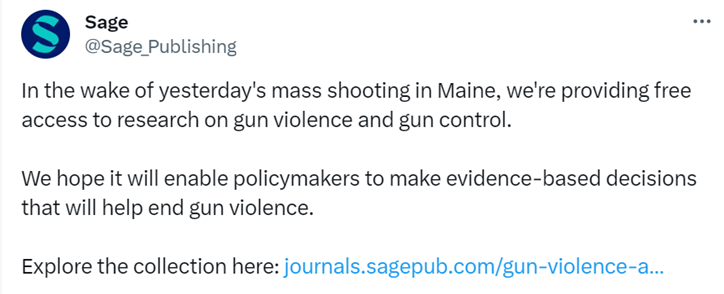
- Do your research.
- Ensure your content is well-researched and backed by credible sources. This helps establish your authority and ensures that the information you share is accurate and trustworthy. It also shows your commitment to presenting a well-rounded perspective.
- Engage thoughtfully.
- Encourage feedback and be open to different viewpoints. Engaging with your audience in a respectful and thoughtful manner can foster a healthier dialogue. Remember, it's not just about sharing content, but about creating a space for constructive discussions.
- Stay professional.
Maintain a professional tone even when dealing with heated topics. Avoid hyperbole and sensationalism. Instead, focus on providing articulate, informed commentary that demonstrates your expertise without talking down to your audience.
Using AI for social media content
Generative AI tools (i.e., conversational software powered by artificial intelligence, like ChatGPT) have been game changers for content creation – including social media content. These tools can help generate impactful social media content and save you time and energy.
Consider utilizing generative AI tools to create content:
- There are many tools available to achieve different goals such as content writing, social media posts, and image generation. This Zapier blog provides a comprehensive but not exhaustive breakdown.
- When entering requests to a chatbot, such as ChatGPT, be specific and detailed as if speaking to a small child.
- Generative AI tools are coachable and can learn your tone.
- Provide sample materials of your tone from previous blogs, social media posts, or personal writing.
- You can continue tweaking this tone by following up with more questions or suggestions within the same chat:
- “I want you to help me create content that is accurate to my voice. What do you need from me to make this information as accurate to me as possible?”
- “This does not sound like me. How do I make it sound more like me?”
- “Let's try this again. Ignore the previous prompt.”
- Always double-check before posting; it is recommended to use a search engine to double-check if the output infringes copyright or is plagiarized. You can check by copying and pasting the output within quotes into a search engine and searching.
X
Formerly known as Twitter, this social media platform rebranded to X in 2023. Changes to the site have caused many users, including academics, to abandon X. At the moment, X remains an active, freely accessible platform for short-form discourse.
Users create handles (e.g. @SageJournals) and share brief posts called tweets. These tweets can contain photos, videos, links, hashtags (e.g. #Sociology, #CarbonFootprint), and mentions of other handles. Users are limited to 280 characters per tweet for free accounts. Users with premium accounts may use up to 4,000 characters per tweet.
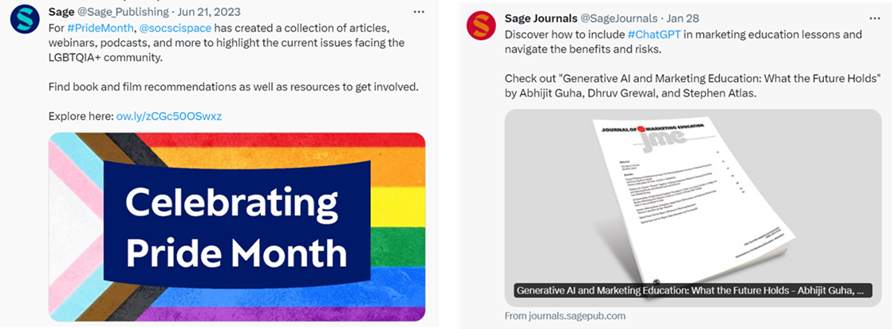
Academics, journal editors, and societies can use X to connect with other academics and the public at large.
We recommend the following best practices for posting to X:
- Keep sentences brief.
- Avoid large chunks of text. Instead, break up tweets into short paragraphs.
- Use proper punctuation.
- Integrate hashtags and mentions into sentences. (See examples above.)
- Be human. A conversational, open tone does well on X.
- Share images formatted to fit the platform. 1600 x 900 pixels is recommended.
- Frequency is important on this platform to build a good number of followers. This can include original content, as well as retweets or links to other content.
- If you choose to leave X, lock your account, and delete all tweets instead of deactivating the account. Anyone can take up a deactivated username and masquerade as the original user.
We have a full list of X social media tips available here, including how to set up an X account, managing an account, additional content suggestions, and how to build a following.
LinkedIn, a Microsoft product, is a professional social network platform where members connect, organize offline events, join groups, write articles, publish job postings, post photos and videos, share relevant resources, and more.
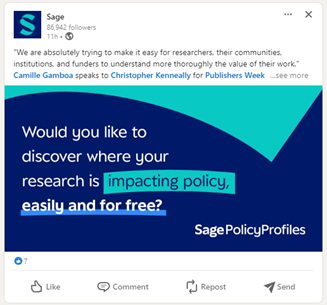
Individual users can create profiles detailing their professional accomplishments and can connect with other users; these sometimes represent real-world professional relationships and networks. Institutions, organizations, and businesses can also create accounts, build followers, and promote initiatives.
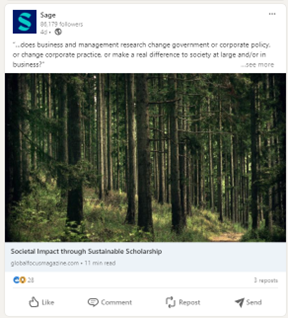
Posting regularly to LinkedIn can build your professional network and promote your work. We recommend the following best practices:
- Engage with the LinkedIn community.
- Spend a few minutes each day liking and commenting. It helps people recognize you, boosts your profile views, and engages the LinkedIn algorithm. Tag colleagues in posts to recognize their accomplishments.
- Mix up your topics.
- Share your work and mix it up with different topics. Share other interesting content through re-posting.
- Use different content types.
- Don't just share links. Try text, images, GIFs, and videos. It adds variety to your post feed and increases engagement.
- Recommended posting times.
- According to a SocialPilot study, LinkedIn users are more engaged during the traditional Monday-Friday work week, with most interaction during the first half of office hours (10 am-2 pm) and during commute hours (7 am-9 am, 6 pm-8 pm).
- Recommended posting frequency.
- SocialPilot advises posting between 2-5 times within the work week.
- Respond to every comment.
- Engagement tells LinkedIn your content is interesting and builds trust with your audience.
- Write in your voice.
- Be human, be conversational, and let your personality shine through.
Meta
In 2021, the company known as Facebook rebranded to Meta. Meta is a tech company known for its social media platforms and virtual reality products.
The main Meta-owned social media platforms of interest to academics are Facebook, Instagram, and Threads.
Facebook is a social networking platform designed for users to share posts, photos, videos, and links with others, known as “friends.” Institutions like academic journals or societies use Facebook to publicize journal updates, share calls for papers and editors, and promote events.
For a public-facing account, such as an account for a journal, ensure that your privacy settings are “public” so that anyone may visit your profile.
When posting to Facebook, include a combination of written and visual content. While the platform allows for longer blocks of text, keep things short and easy to read.
We have a full guide available on tips for posting to and managing a Facebook account.
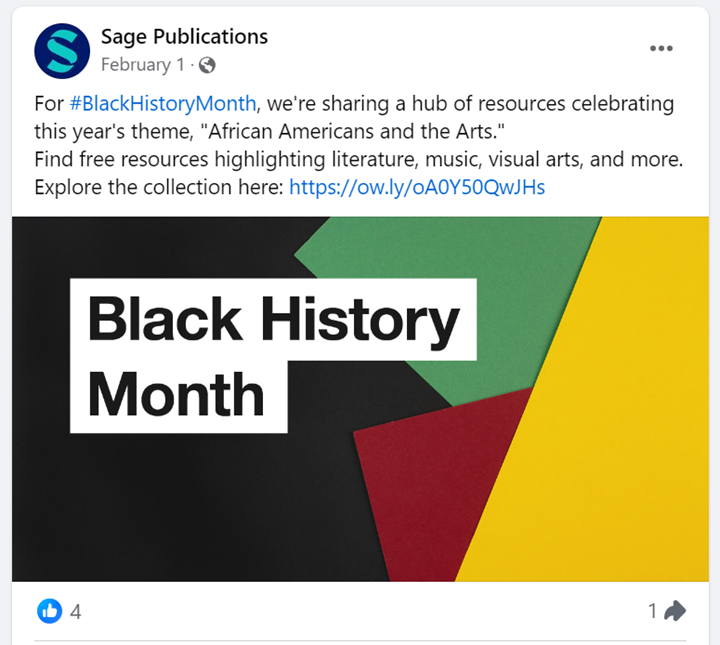
Instagram is a photo and video sharing platform and social networking service. Many academic institutions and organizations use Instagram to share updates and research.
|
There are several ways to share content to Instagram:
When developing an Instagram strategy, consider how you can share and save content to Instagram. If you want to promote a Call for Papers, you could hold a Q&A with Instagram Live, share a feed post and pin it to the top of your profile, and create a series of Stories. |
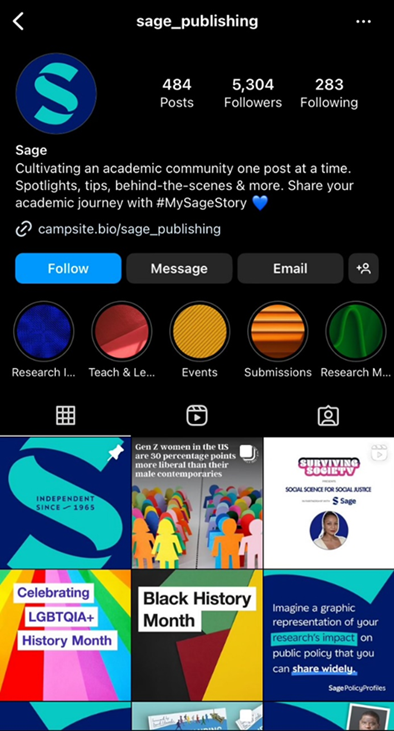 |
This platform is unique because link sharing is not allowable in a post, only in your bio. Because of this, the focus for Instagram is on engagement within the network instead of driving traffic to your research or journal.
Threads
Launched in 2023, Threads aims to replicate the functionality and atmosphere of X. Threads users can share text, images, and video as well as interact with other posts by replying, reposting, and “liking.” Whether Threads will emerge as a viable replacement for X remains to be seen.

Threads is closely linked to Instagram, and Meta requires that Threads users first create an Instagram account. Your Threads handle will be the same as your Instagram handle.
Our advice for using Threads is similar to our preceding advice for X. Note that Threads has a limit of 500 characters per post.
Learn more about using threads to promote your research in this LinkedIn article.
TikTok
With over an estimated billion active users, and a search engine that has outperformed Google, TikTok is an increasingly popular platform to share research and resources.
To succeed on TikTok, follow these strategic tips:
- Utilize TikTok’s resources.
- Go to their Creator Academy to learn how to best utilize the platform, the analytic tools, and to review their safety and accessibility tips.
- Optimize posting times.
- Generally, it is best to post during the week, after 9 am according to recommendations from SocialPilot; if you’re new to TikTok, we recommend reading their blog for a break-down of best times to post per day. Once you’ve built an audience, utilize TikTok's analytics tools to monitor follower growth and engagement metrics to inform your posting schedule.
- Speak to your community.
- Use the algorithm to speak to your research community. Experiment with various content types to discover what works best with your audience and then maintain consistency.
- Hashtags recommendations.
- TikTok recommends 2-3 hashtags per post. For more visibility, employ a mix of niche and popular hashtags. This can increase discoverability and reach, catering to both engaged and broader audiences.
- Content recommendations include:
- Incorporate trending audio.
- Utilize popular audio clips to enhance the appeal of your content and stay relevant within the TikTok community.
- Keep low-performing videos.
- Avoid deleting videos that underperform initially, as the algorithm may still promote them to the right audience over time. Virality can occur unexpectedly.
- Utilize the stitching feature.
- Collaborate with other creators and expand your reach by stitching together relevant or high-performing videos within your niche.
- Leverage the green screen effect.
- Enhance storytelling by using TikTok's green screen effect to incorporate visuals that complement your content, adding depth and engagement to your videos.
- Respond to comments with video.
- Enhance audience engagement by responding to comments with video content, addressing inquiries, and providing valuable insights or demonstrations.
- Include call to actions for engagement.
- Encourage user interaction and drive specific actions by including clear calls-to-action in your video descriptions and comments, guiding viewers towards your intended goals or further engagement opportunities.
Blogs and community websites
In addition to sharing social media content, academics can share their research by contributing to blogs or other websites. A blog is a website in which one or more writers share brief entries called blog posts. Blogs posts might be written by the site owner or by guest contributors.
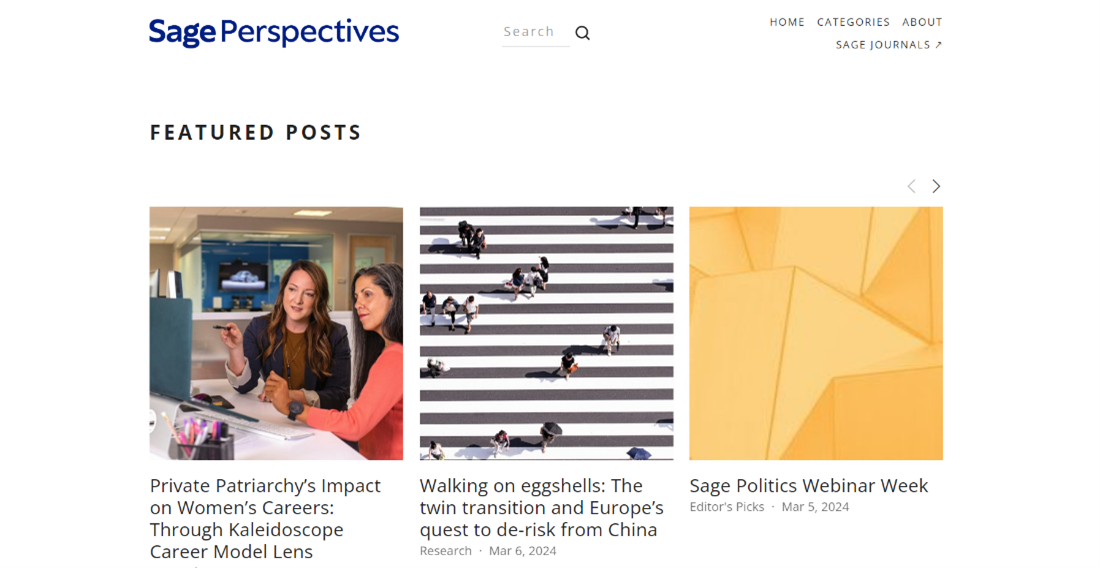
Examples of blogs and community websites include Sage Perspectives, Business and Management INK, and Social Science Space, which highlights topical and interesting research published in Sage books and journals, and Sage Research Methods Community, an online hub for resources about social and behavioral research methods where scholars and students can share experiences and learn how to improve their research and writing.
If you are asked to contribute to a blog or website (or choose to blog from a personal site or account, such as LinkedIn), consider the following strategies:
- Read and follow all instructions closely.
- Does the website have a preferred word limit? How are references cited? Is your audience other scholars or the public at large?
- If asked to include a photograph, use a high-resolution photo.
- Write a brief bio.
- Be sure to include your field of study, current affiliations, and recent publications.
- Link your website or social media handle(s) as appropriate.
- Be open to suggestions.
- The site owner might require revisions before they publish your blog post.
- Ask if the blog post will be marketed.
- If the site owner intends to share the blog post on X, ask if they can mention you, and be sure to share their tweet.
Listservs
Listservs (short for “list servers”) are email distribution systems used to send messages to large groups of subscribers. Users who subscribe to a listserv receive all messages sent to the listserv email address.
Listservs can be used by researchers in the following ways:
- For discussion and collaboration.
- Listservs allow researchers to engage in discussions related to their respective disciplines and engage in networking and research support.
- To announce updates and events.
- Universities, academic departments, and journals can use listservs to share relevant news and events.
- Researchers affiliated with a university are often automatically subscribed to several institution-specific listservs.
- Universities, academic departments, and journals can use listservs to share relevant news and events.
- To connect with others.
- Special interest and niche listservs can keep subscribers up to date on research in their field and help them connect with fellow researchers.
- For example, ASA sponsors communities such as Filipino Sociologists, First-Generation and Working-Class Sociologists, and Sociologists Working Everywhere—each of which features a listserv for notifications and communication.
- Special interest and niche listservs can keep subscribers up to date on research in their field and help them connect with fellow researchers.
To find relevant listservs, search online for listservs in your field (for example, “economics listserv” or “music education email discussion group”). You can also see if any professional organizations, academic journals, or institutions associated with your field host listservs.
Listserv managers should establish clear guidelines and moderate email communications to ensure that discussions remain on topic and appropriate. Managers should also protect user privacy, such as their contact information, and allow users to unsubscribe easily.
Listserv communication should follow all guidelines, be professional in tone, and include a brief, descriptive subject line.
YouTube
YouTube is a video-sharing platform that allows users to upload, share, and view videos. Billions of users from around the world access the platform each month.
YouTube may require more time and effort than some other social media platforms.
Academics, societies, and journal editors can use YouTube in the following ways:
- Share videos of research findings or abstract summaries.
- Record and upload virtual webinars or live events.
- Upload video recordings of podcast episodes.
- Announce call for papers, special issues, etc.

If you choose to use YouTube for your journal or society, we recommend the following:
- Use the colors, fonts, and logos associated with your journal or society for your profile and banner images.
- Ensure these are high-quality and not blurry. Reach out to your Publishing Editor if you need high resolution images or color palettes.
- Include a description and relevant links in your About section.
- Organize videos into Playlists.
- Add and edit auto-captions for accessibility.
- Strive toward high-quality videos that appear organized and professional.
- Aim for a variety of content.
- Upload new content at least once a month.
Researcher Profiles
Researcher profiles are digital platforms that serve as online portfolios showcasing a scholar’s research. Popular researcher profile platforms include ResearchGate, ORCID, and Web of Science profiles.
Sage Policy Profiles is a new platform for researchers to see specific citations of their work in policy documents and discover the real-world impact of their research.
Here are some tips for getting the most out of your researcher profiles:
- Be choosy.
- Only pick platforms that align with your research and discipline.
- Complete your profile and update it often.
- This means uploading a photo, writing a brief bio, and updating your affiliations and publications as needed.
- If others attribute papers to your account, these papers may appear on your profile—even if you did not actually author them. Check your profile often and remove any papers to which your account was accidentally tagged. (For example, if you share the same name as another researcher.)
- This means uploading a photo, writing a brief bio, and updating your affiliations and publications as needed.
- Be professional.
- While other social networking sites are more casual, researcher profiles should be approached as online portfolios.
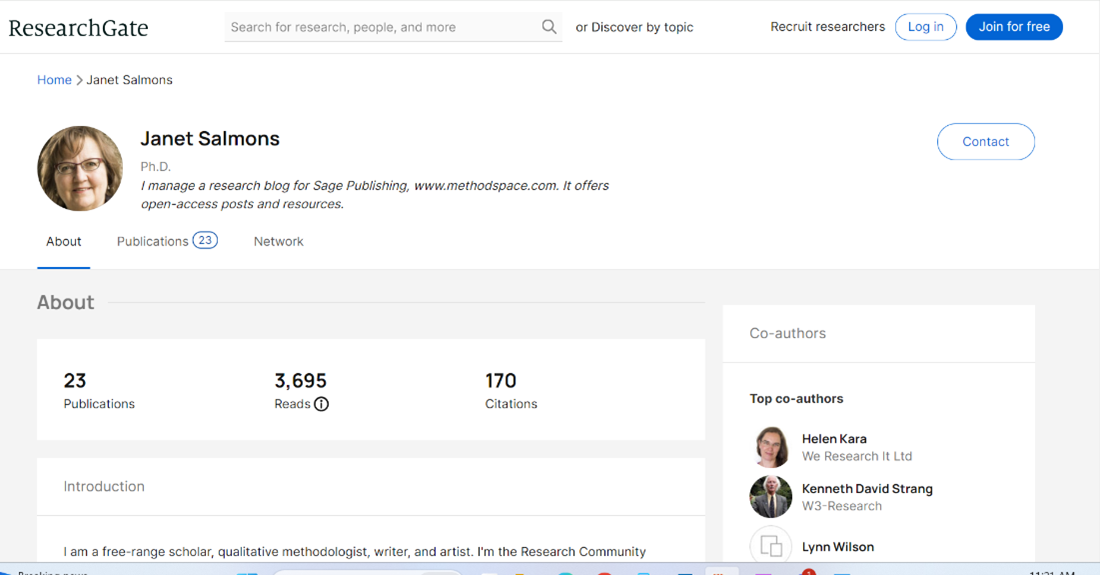
WeChat is a Chinese “super-app” used for social media, instant messaging, and more.
Accounts linked with Chinese Mainland phone numbers operate under the Weixin or 微信 brand, while external numbers are managed under WeChat. Data is stored, analyzed, and tracked differently depending on whether a user is registered under Weixin or WeChat, but the user interface is similar.
Sage uses WeChat to engage with scholars located in China.
When using WeChat, we recommend the following:
- Create an Official Account for your journal.
- A WeChat Official Account provides analytics and other useful features.
- Join WeChat groups.
- Scholars can join or create groups related to their specific academic discipline.
- Repost content from other accounts.
- Expand your WeChat presence with a variety of content. You can share research articles, video recordings, podcasts, and more.
- Avoid sharing political content.
- The most popular WeChat content from Sage includes journal milestones, special issues, author services, and calls for board members, reviewers, and papers.
- Share content WeChat users want to see.
- Content related to global news, relevant to a Chinese audience, or on new academic trends or topics of general interest also do well on WeChat.
Blogging
Sage also runs a variety of blog sites to share topical and thought-provoking articles, interviews, videos and features to engage with the academic community. They include:
Sage Perspectives blog
Sage Perspectives blog focuses on highlighting topical and interesting research published in Sage books and journals. The blog includes posts from authors across a wide range of subject disciplines and research areas.
Social Science Space
Social Science Space brings social scientists together to explore, share and shape the big issues in social science, from funding to impact. This online social network features blogs with the most current thinking from key players in social science. It is an active forum for discussions, a resource center with free videos, reports and slides that support these discussions, as well as funding and job opportunity notices. If you have a piece of research publishing that engages with these big issues in social science get in touch.
MethodSpace
MethodSpace is an online community for research methods. The purpose of the site is to connect researchers to discuss methodology issues and controversies, discover and review new resources, find relevant conferences and events, and share and solve methodology problems.
Press Releases
The Sage Press Release Toolkit is a valuable resource for editors aiming to promote their journal's research to the wider media. The toolkit will guide you, the editor, through the process of determining whether an article is newsworthy. It will help you write the press release and provide helpful tips and tricks for drafting an effective press release. A press release template is also available for editors to share, download and use.

Journal Prizes
Why not consider introducing a best paper prize or other award in order to promote your journal to potential authors and raise your profile? The prize could be awarded to the most highly cited paper, the best paper by an early career academic or postgraduate, or simply the paper that best advances the aims and scope of the journal. The winning paper could then be promoted via the journal’s website. Ask your Sage Editor for advice.
Sage is committed to promoting and increasing the visibility of the journals we publish. For further information on any of the above please contact your Sage editor.